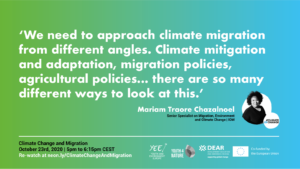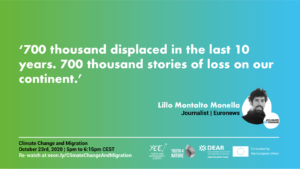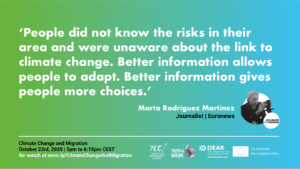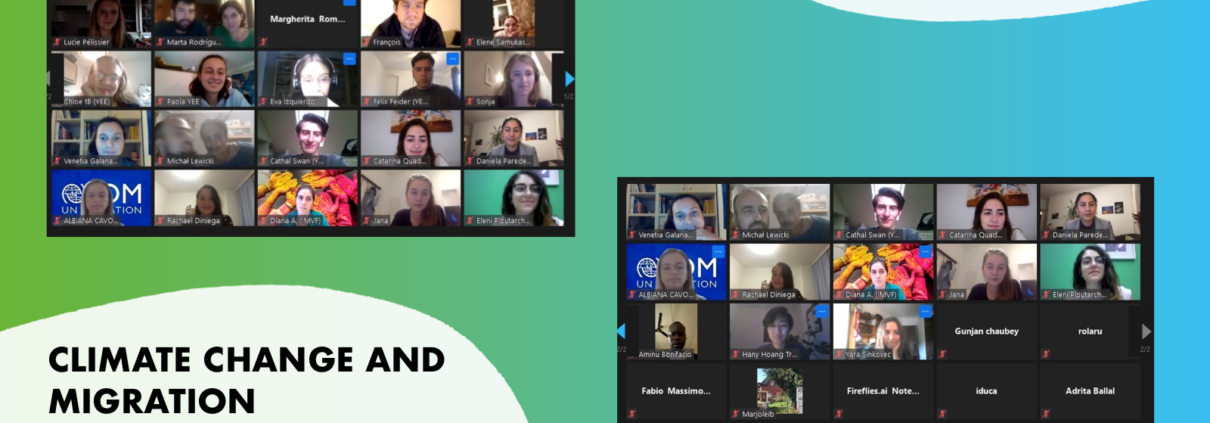Online Panel Discussion on Climate Migration / #ClimateofChange
On the 23rd October, YEE together with the EEB co-hosted a webinar on climate migration as part of its #ClimateofChange project, a pan-European campaign to build a better future for climate-induced migrants, the human face of climate change. In case you weren’t able to make it, you can watch it here, read a summary of the event below , and if you did manage to join us and want to learn more about the topic, we have assembled some additional resources for you below!
Elisha Winckel, our Liaison Officer on Climate Change led through the event – introducing the speakers and facilitating the interaction between the audience and panelists. Natalie Lupi (Climate of Change Project Coordinator) launched YEE’s #ClimateOfChange series by providing an overview of the greater campaign and emphasised the need to act on climate migration. The ensuing presentations, by representatives from academia, civil society, journalism and international governance, were structured to provide people listening in a broad overview of the topic – the controversies surrounding it, the measures being discussed and taken, and a glimpse of the experiences of the people affected by a changing climate.
Dr. Caroline Zickgraf (Co-Founder and Deputy Director of the Hugo Observatory at University of Liège) introduced the topic of climate migration and highlighted three key considerations when dealing with the subject. Firstly, what’s the right term? Climate refugees? Environmental migration? Climate and migration? The answer depends on where the focus should lie, that is the people affected or the phenomena. Using the term “human mobility” encompasses forced migration, displacement and voluntary migration. Secondly, how many people are we talking about? Naturally, knowing the numbers helps policymakers and organisations but they need to be taken with a grain of salt. A lot of the numbers out there focus on the future not the present, meaning that they only provide a glimpse of a possible scenario. Another problem are the guesstimates used to scare people into climate action. The result? Restrictive migration policies that further harm affected people. (One of the most trustful sources on current numbers is the Internal Displacement Monitoring Centre). And lastly, where do people go? Fear-mongers warn of millions and millions of people coming to Europe. The reality is far from that. Most people move within their country, and if they do move or are displaced across borders, it is usually to neighbouring countries.
Senior Expert in Migration, Environment and Climate Change at the International Organization for Migration (IOM), Mariam Traore Chazalnoel, started on an encouraging note. She clearly sees a rise in interest in human mobility in UN policy discussions, for her a way to gauge the political will to tackle the issue.  Over the last years two major international developments are especially notable: the creation of a UNFCCC Taskforce on Disaster Displacement, and the Global Compact for Safe, Orderly, and Regular Migration, the first international agreement setting out objectives and commitments to respect when managing migration. However, this progress has mainly been concentrated on the realm of principles, with legislations and actual practices only slowly changing. “There’s also a bigger push by young people to have a seat at the table in the policy debate”, Mariam pointed out. “For while their voices were missing”, she went on, “but their involvement can transform the narrative into one that is more hopeful and aspirational.”
Over the last years two major international developments are especially notable: the creation of a UNFCCC Taskforce on Disaster Displacement, and the Global Compact for Safe, Orderly, and Regular Migration, the first international agreement setting out objectives and commitments to respect when managing migration. However, this progress has mainly been concentrated on the realm of principles, with legislations and actual practices only slowly changing. “There’s also a bigger push by young people to have a seat at the table in the policy debate”, Mariam pointed out. “For while their voices were missing”, she went on, “but their involvement can transform the narrative into one that is more hopeful and aspirational.”
Lucie Pélissier (Co-President of CliMates and consultant for des Ponts pas des Murs) underlined what Mariam said, “4 years ago, there was hardly any awareness on the issue”. People did not grasp the extent of the question at hand, and as emotional first-hand accounts were tough to come by, she got involved in doing a web-documentary on people in Senegal and Bangladesh displaced by a changing climate.
70.000 people are displaced by weather events in Europe every year. In the last 10 years that amounts to 700.000 stories of loss. But who were those people? Our last two speakers, Marta Rodriguez and Lillo Montalto, decided to look past the numbers and find some of the people whose lives were disrupted.  They tracked down people all across Europe, recording the stories of people who decided to stay back in ghost towns, like Ion Sandu in Cotul Mori, Moldova. Their investigation also brought them to La-Faute-Sur-Mer in France, where they talked to the Biraults who rebuilt their home after a severe flood destroyed it. Despite being able to rebuild, they feel like strangers in a new home. Marta and Lillo, also tracked down people who had to move away, like Zekira Ikanović. Despite being able to rebuild her life, she feels like a migrant away from home, even though she stayed in her own country. You can read and see all about these people and others in Euronews’ web series on Europe’s Climate Migrants.
They tracked down people all across Europe, recording the stories of people who decided to stay back in ghost towns, like Ion Sandu in Cotul Mori, Moldova. Their investigation also brought them to La-Faute-Sur-Mer in France, where they talked to the Biraults who rebuilt their home after a severe flood destroyed it. Despite being able to rebuild, they feel like strangers in a new home. Marta and Lillo, also tracked down people who had to move away, like Zekira Ikanović. Despite being able to rebuild her life, she feels like a migrant away from home, even though she stayed in her own country. You can read and see all about these people and others in Euronews’ web series on Europe’s Climate Migrants.

The webinar then allowed participants to put their questions to the panel, such as how climate migration can best be addressed within international political frameworks and the implications of considering climate migration as an adaptation to climate change. The event finally concluded with closing statements from our speakers illustrating how – unsurprisingly – “solving” climate migration is very complex, but emphasising how it requires a bottom-up approach that listens to the perspectives of the people affected and acknowledges that climate migration has and always will be an issue and is not inherently problematic, although many instances and aspects of it can be.
If you want to learn more about climate-induced migration, why not start with these amazing resources?
This brief but sharp take-down of climate migration myths is a great way to introduce you to the topic and dispel misunderstanding.
This short report gives an excellently clear and informative explanation of the terminology, data, and different historical approaches.
This recent series explores many interesting aspects of the intersection between the Covid-19 pandemic and climate migration.
This page shows a whole series of recorded webinars and short videos on climate migration for a very in-depth audio-visual explanation.
Here is a podcast from a top-quality development website regarding climate migration, especially in small island developing states (SIDS) like Kiribati.
And if you’re feeling very brave, here are two landmark, high-level reports on climate migration from 2015 and 2018!



 YEE aims to unite environmental youth non-profit organisations in Europe in order to enhance international cooperation, increase knowledge about the climate crisis, raise awareness of environmental problems and to strengthen participation of youth in environmental decision-making.
YEE aims to unite environmental youth non-profit organisations in Europe in order to enhance international cooperation, increase knowledge about the climate crisis, raise awareness of environmental problems and to strengthen participation of youth in environmental decision-making.




Leave a Reply
Want to join the discussion?Feel free to contribute!